 Nihhon Kaigun (1900-1922): Armoured Cruiser (Sōkō jun’yōkan)
Nihhon Kaigun (1900-1922): Armoured Cruiser (Sōkō jun’yōkan)
Yakumo (“Eight Clouds”) was an armored cruiser built for the Imperial Japanese Navy in 1897-1900 in Germany due to limitations and capacity of Japanese naval yards at the time in preparation of a possible war with Russia. Another was ordered from France following four from Britain. Yakumo took part in naval battles of the Russo-Japanese War of 1904–05, lightly damaged at the Battle of the Yellow Sea and the Battle of Tsushima. She trained crews during World War I and from 1917, multiplied cruises to China, albeit not reclassified as a training ship until 1931. She made a world tour and several long ones in the inetrwar, and a last cruise in 1939 but continued as such in home waters until 1945. Postwar repatriation transport, she stricken and BU on 1946–47. #ww2 #ww1 #IJN #imperialjapanesenavy #japanesenavy #nihhonkaigun

Development
IJN Yakumo was one of the rare ships built in Germany for Japan. Relations with the German Empire were neither icy nor excellent and only degraded slightly after the 1903 alliance with Britain. The paradox was that the Japanese in 1914 chased off the German east Asian squadron and besieged the colony of Tsingtau. However German yards had some capacity to spare. The ship was planned as part of the 1896 Naval Expansion Plan following the First Sino-Japanese War, four armored cruisers and four battleships or “4-4 plan”. Having no free capacity all were to be ordered aboard. The plan was also revised due to the intensive Russian shipbuilding program. The plan was deemed no longer sufficient in 1897 but budgetary limitations prevented to purchased more battleships so instead, it was chosen six (two more) armored cruisers.
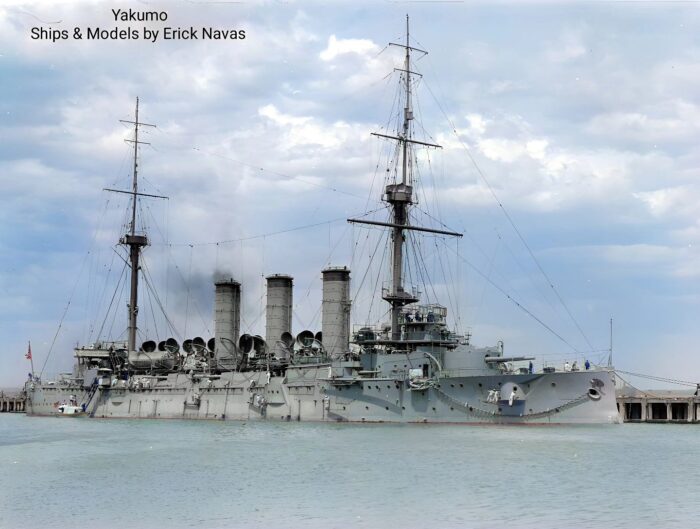
Yakumo in 1928, colorized by Erick Navas src
As for Germany as provider, it was believed that the new, tougher Krupp cemented armor would offer an advantage on all these, in the line of battle. This became the “Six-Six Fleet”. The first four were ordered to Armstrong Whitworth in UK and the last two Germany and France. For ammunition compatibility, the IJN wanted British guns installed on both. The IJN came with a sketch design and specifications and each builder was to make a technical proposal for approbation, but otherwise free to define its details. Unlike French or German practice where Armoured cruisers were designed to prey on trade and defend colonies, these were designed as fleet scouts and to integrate the battleline. In short, they were the forerunners of battlecruisers.
IJN Yakumo was thus ordered on 1 September 1897 at AG Vulcan Stettin, Stettin in Germany, laid down on 1 September 1897, launched on 8 July 1899 and completed on 20 June 1900 about four years. She resembled nothing like contemporary German cruisers of the time.
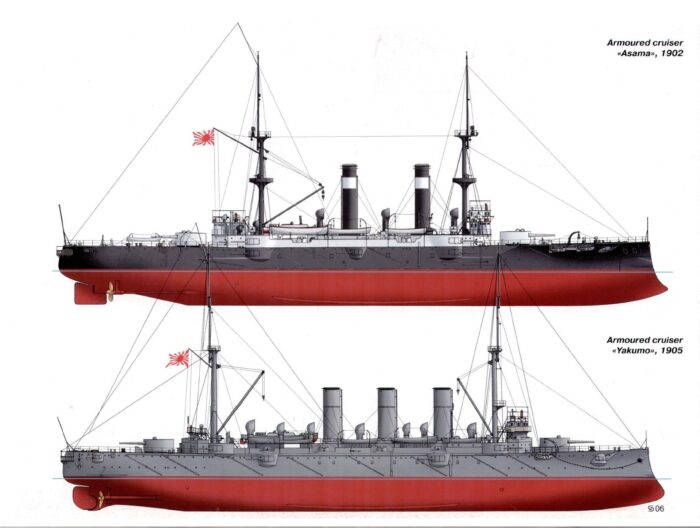
Yakumo and Asama of the “6-6” plan. (pinterest)
Design of the class
Hull and general design
Yakumo measured 132.3 meters (434 ft 1 in) overall but 124.64 meters (408 ft 11 in) between perpendiculars, with a classic axe shaped ram. For a beam of 19.57 meters (64 ft 2 in) she had a 7/1 ratio and an average draft of 7.21 meters (23 ft 8 in). Standard or normal load displacement was 9,646 metric tons (9,494 long tons) and up to 10,288 metric tons (10,126 long tons) when deeply load. Her metacentric height was 0.95 meters (3 ft 1 in) so she was relatively balanced. Her double bottom was completed by and underwater subdivision between 247 watertight compartments that could be filled with extra coal.
Her crew comprised 670 officers ratings for which she was fitted with a dozen boats of all types, including six under davits and the remainder aft of the funnel, lanaged by the mainmast aft’s boom crane. She had a typical profile with two equal size masts, military in the sense they were thick, but only supported light platforms. They received two composed upper masts supporting. The superstructure ran from the small bridge, which ast above the conning tower, with an open bridge above, along the axis and three equally spaced funnels, to a small prismatic structure aft mirroring the oen forward and carrying small deck guns. She had sponsoned, turreted and shielded guns between the hull and deck. The hull had counter-keels.
Protection
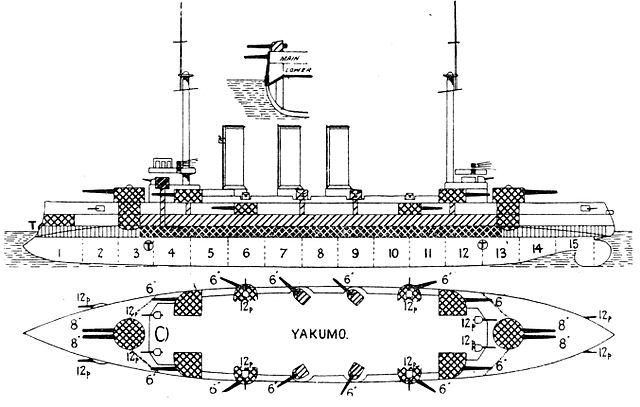
All the plan’s cruisers were specified with the same armour scheme. There were of course minor differences per yard: The later ships used Krupp cemented armor and that included Yakumo.
Waterline belt: full length, 178 mm (7 in) amidships, 89 mm (3.5 in) bow and stern over 2.13 meters (7 ft) inc. 1.49 m (4 ft 11 in) underwater.
Upper belt strake: 127 mm (5 in), extended from the upper edge to the main deck over 61.49 m (201 ft 9 in) between barbette.
Armoured Bulkhead: Single transverse 127 mm (5 in), forward end citadel.
Main Barbettes/Turrets: 152 mm (6 in).
Casemates: 51 mm (2 in)
Deck: 63 mmm (2.5 in)
Conning tower: 356 millimeters (14 in).
Powerplant
Yakumo was powered by two 4-cylinder triple-expansion steam engines with a single three bladed propeller shaft each, steam coming from 24 Belleville boilers, engines rated at 15,500 indicated horsepower (11,600 kW). Designed speed was 20 knots (37 km/h; 23 mph) but she managed 21.005 knots (38.901 km/h; 24.172 mph) on sea trials based on 16,960 ihp (12,650 kW). With 1,300 metric tons (1,300 long tons; 1,400 short tons) of coal, her range was of 7,000 nautical miles (13,000 km; 8,100 mi) at 10 knots (19 km/h; 12 mph) cruise speed.
Armament
20.3 cm/45 Type 41 naval guns
The standard armament adopted for all the 6-6 plan was the same, the armoured cruisers were given four Armstrong Whitworth-built 45-caliber eight-inch guns. They came out in two twin turrets fore and aft. They were electrically operated for a 130° rotation left and right, max elevatation to +30°, max depressed to −5°. There were already 65 ready rounds in the turrets, the remainder being reloaded through doors in the turret floor with an electric winch to hoist these from the shell room below. The grand total was 320 eight-inch shells. They were manually loaded at fixed angle so for a rate of fire about 1.2 rounds per minute. These were 113.5-kilogram (250 lb) armor-piercing (AP) shelled capable of a muzzle velocity of 760 meters per second (2,500 ft/s) and max range of 18,000 meters (20,000 yd).
QF 6 inch /40 naval guns
The secondary armament comprised twelve Elswick Ordnance Company “Pattern Z” quick-firing (QF) and 40-caliber 6-inch (152 mm) guns. Four were not mounted in armored casemates on the main deck, the remainder shielded on the upper deck. They fired a 45.4 kilograms (100 lb) AP shell at a muzzle velocity of 700 meters per second (2,300 ft/s). 150 rounds were provided for each gun, making for a total of 1800 shells total.
QF 12-pounder 12 cwt naval guns
Yakumo had in reinforcement for close ranges against destroyers a dozen of 40-caliber Quick Firing 12-pounder 12-cwt guns, caliber 76-millimeter or 3 inches. They fired a 5.7-kilogram (12.5 lb) shell at a muzzle velocity of 719 meters per second (2,359 ft/s). Unitary shells for quick reload, range 11,750 yd (10,740 m) at 40° elevation. Four were mounted in casemates on the battery deck, and the remainder located either along the weather deck bulwarks over the secondary guns casemates, and four each on the forward and aft structures.
QF 3-pounder Hotchkiss guns
She rounded her defensive armament with eight QF 2.5-pounder Yamauchi guns for close-range defense. Similar to the standard Hotchkiss light, one man pintle mounted guns seen on other vessels. Location is unclear. They fired a 47 mm Fixed QF 47 × 376 mm R 3 kg (6.6 lb) round at 30 rpm to 571 m/s (1,870 ft/s) and 5.9 km (3.7 mi) max at +20°.
457 mm (18 inches) Whitehead Torpedo Tubes
Yakumo was equipped with five 457 mm (18.0 in) torpedo tubes: One above water, bow, then four submerged, broadside. They fired the Type 30 torpedo, a copy of the WXhitehead Mark I with a 100-kilogram (220 lb) warhead, three range/speed settings: 800 meters (870 yd) at 27 knots (50 km/h; 31 mph), 1,000 meters (1,100 yd) at 23.6 knots (43.7 km/h; 27.2 mph) or 3,000 meters (3,300 yd) at 14.2 knots (26.3 km/h; 16.3 mph).
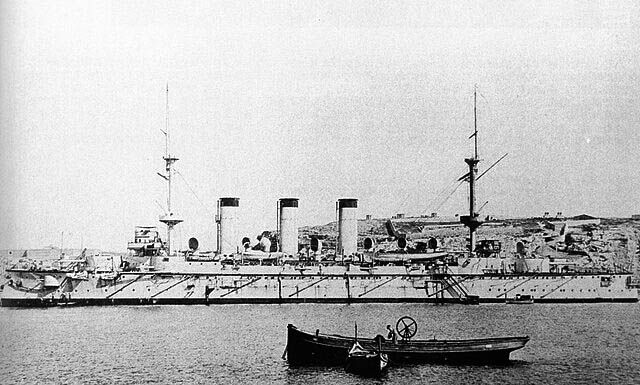
Yakumo as completed
⚙ Yakumo 1897 specifications |
|
| Displacement | 9,646 t (9,494 long tons) |
| Dimensions | 132.3 x 19.57 x 7.21: (434 ft 1 in x 64 ft 2 in x 23 ft 8 in) |
| Propulsion | 2 shafts VTE engines, 24 Belleville boilers, 15,500 ihp (11,600 kW) |
| Speed | 20 knots (37 km/h; 23 mph) |
| Range | 7,000 nmi (13,000 km; 8,100 mi) at 10 knots (19 km/h; 12 mph) |
| Armament | 2×2 20.3 cm/45, 12× QF 6 in/40, 12× QF 12-pdr 12 cwt, 8× QF 3-pdr Hotchkiss, 5× 457 mm TTs |
| Protection | Belt 89–178 mm, Deck 63 mm, turret 160 mm, Barbette 152 mm, Casemate 51–152 mm, CT 356 mm, Bulkhead 127 mm |
| Crew | 670 |
Career of IJN Yakumo
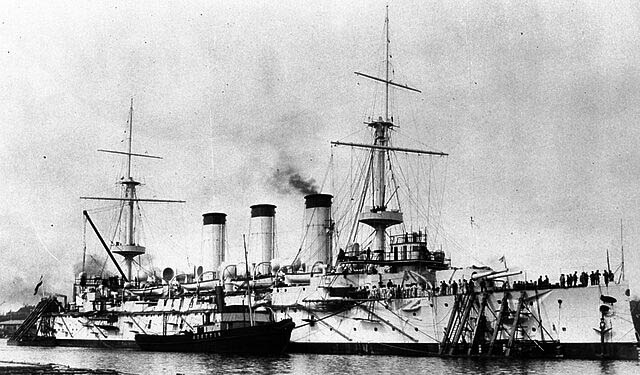
Yakumo was named after a stanza of the waka poem by Susanoo (Japanese mythology). She was was completed on 20 June 1900 and departed Stettin two days later for Yokosuka on 30 August. When the Russo-Japanese War flare out she was assigned to the 2nd Division, 2nd Fleet. She was present for the Battle of Port Arthur on 9 February 1904 led by Vice Admiral Tōgō Heihachirō on the Pacific Squadron anchored outside the port. Tōgō sent first his destroyers but after the Russians recovered from their surprise a duel was engaged with the Japanese ships, first the protected cruiser Boyarin. Tōgō preferred to silence first the coastal defenses with his main armament and used secondary guns for the incoming Russians bu this was apoor decision, that led to little damage. Russian casualties were about 150, Japanese 90 killed when Tōgō disengaged. Yakumo was not hit but damaged the protected cruiser Novik with her main guns.
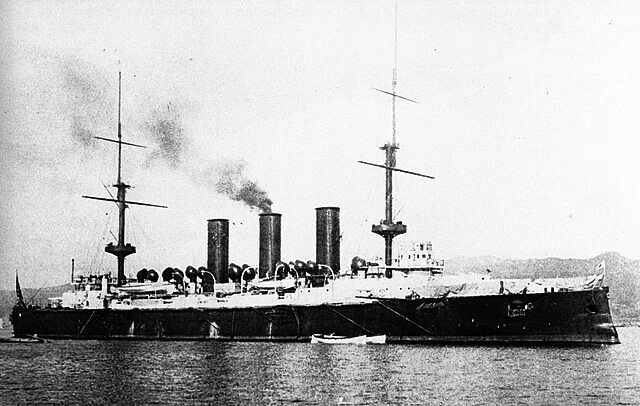
In early March under Vice Admiral Kamimura Hikonojō she was sent to the 2nd Division north to create a diversion off Vladivostok. With other cruisers she bombarded the harbor and defenses to little effect on the 6th. Back to Japan the Division escorted transports wit the Imperial Guards Division to Korea and then join the blockaded of Port Arthur. Yakumo was transferred to Rear Admiral Dewa Shigetō’s 3rd Division and on 23 June, she became flagship. She took part in the battle when the Pacific Squadron sortied to reach Vladivostok but quickly returned before sunset.
On the morning of 10 August 1904, Dewa’s cruisers were standing 15 nautical miles (28 km; 17 mi) south of Tōgō’s 1st Division whene there was another attempt to reach Vladivostok. In the early stages of the battle, Dewa straddled Russian cruisers trailing the battleships until rebuffed by the battleships.

Dewa closed with the Russians in the afternoon when a 12-inch (305 mm) shell hit Yakumo amidships at 15:40, killing 12, wounding 11 and the distance fell to 8 nautical miles (15 km; 9.2 mi) when order was given to disengage. By 17:45, Yakumo was back to 8,000-9,000 meters from Poltava and hammered her until close enough toi use all thei light guns. The death of adm. Vitgeft at 18:40 caused the remainder to split, some fled to Vladisvostok, the rest into Port Arthur. The 3rd Division was order to circle the Russian ships but fired on them with little effect, until Tōgō wanted Dewa to concentrate on Russian destroyers at 19:44. Instead he veered south around 20:00 in chase of fleeing Russian cruisers until reaching isolated flotillas of destroyers and torpedo boats. But Dewa broke off the pursuit at 20:25 and veered south-eastwards until spotting a cruiser and two destroyers, could not catch them.
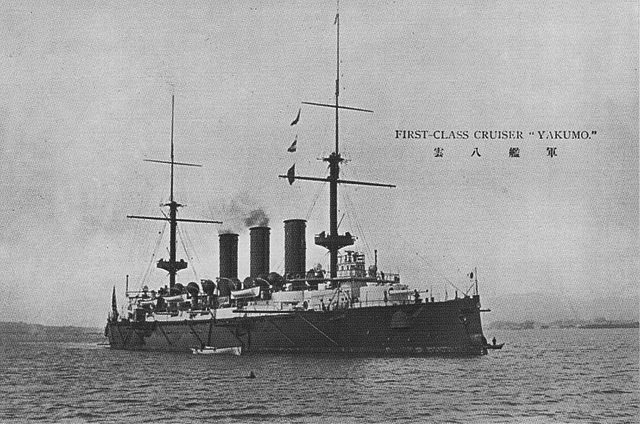
On 14 August, Yakumo and the 3rd Division sailed for Qingdao to confirm the Germans internment of Tsesarevich and three destroyers, then returned to the blockade.
By mid-September, Yakumo was reassigned to Kamimura’s 2nd Division defending the Strait of Tsushima, until refitted and back on 15 November, as flagship. On 13 December she rescue survivors from Takasago (mine). She had a new refit at Sasebo and back on 1 February to the 2nd Division blockading Vladivostok for a few weeks until refitted again at Kure later in February and traning in the strait for the incoming, battered Baltic Fleet (now 2nd pacific fleet).
In the Battle of Tsushima she was in the 2nd Division, 2nd Fleet. It spotted the Russian ships under Vice Admiral Zinovy Rozhestvensky at around 11:30 and she closed to about a range of 8000 meters before being order to join Tōgō’s battleships line. Yakumo was fourth in line. She engaged ships of the 2nd Pacific Squadron at 14:10, ocncentrating on order on Oslyabya, whioch fell out of formation at 14:50 and sank later. In the mist she encountered the battleship Knyaz Suvorov at 15:35 at 2,000 meters (6,600 ft) and Yakumo engaged her with all guns blazing for five minutes alongside Azuma, both firing torpedoes without effect.
After 17:30 the division attemped to catch the fleeing Russian cruisers, leaving Tōgō’s battleships alone, under abandoning the chase around 18:03, joining Tōgō. They caught the rear of the Russian battleline at 18:30 and engaged them at 8000–9000 meters until 19:30 and rejoined Tōgō at 20:08. The next morning there was anotehr engagement at 10:30, beyond range but innefectual. This ended when Rear Admiral Nikolai Nebogatov decided to surrender as they were surrounded and could not close the range, running out of coal and ammuntions.
Admiral Ushakov was latter spotted and Yakumo was ordered to catch her but was defeated by her inferior range and blasted until she was abandoned and scuttled. 12 officers and 327 crewmen were rescued by the cruisers. Yakumo and Iwate fired a total 89 main and 278 secondary rounds on her. She only had been hit by a single 12-inch shell and six more, 3 of which were 6-in shells. Damage was light. On 14 June, Yakumo was the flagship of Vice Admiral Kataoka Shichirō, 3rd Fleet sent to the island of Sakhalin in July 1905.
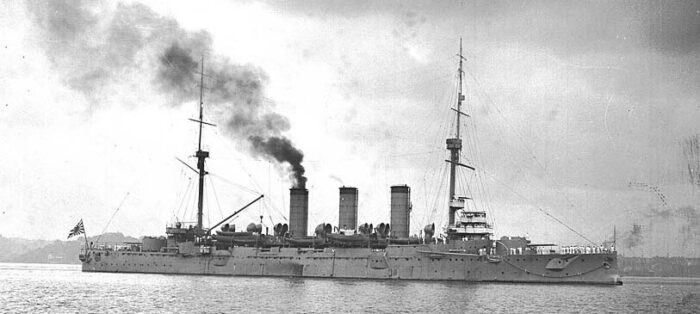
In November 1914, Yakumo was at Singapore, ordered to look for the German commerce raider Emden, she was soon sunk. She remained as flagship of Destroyer Squadron 2 from 13 December 1915 to 1 December 1916 and Sqn. 1 from 1 to 12 December. In February 1917 she patrolled the South Pacific and Indian Oceans for German commerce raiders. She made her first training cruise on 5 April for North America and Hawaii,, back home on 17 August. In October 1918 she had a new capatin, Kichisaburō Nomura for two months. On 1 September 1921 she became a “1st class coast-defense ship”, used for training, long-distance oceanic navigation, officer training for cadets with the Academy. She made 13 more voyages in the interwar, between Europe, North and South America as well as far as Australia with a circumnavigation from August 1921 to April 1922 with Izumo.
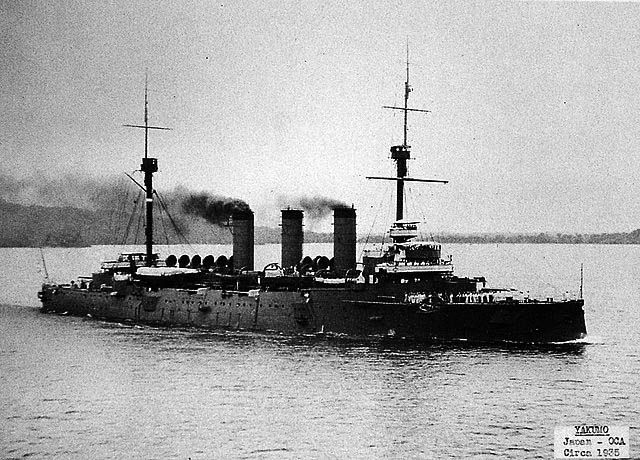
ONI photo, 1935
In 1924, she was refitted: Four 12-pounder removed, and all her QF 2.5-pounder and TT removed, whereas a single 8 cm/40 3rd Year Type AA gun was added. In 1927 her boilers were replaced. She had six Yarrow mixed-burning boilers from IJN Haruna, and went down to 7,000 ihp (5,200 kW), 16 knots (30 km/h; 18 mph). She had 1,210 tons of coal and 306 metric tons of oil on board.
When visiting Qingdao in 1932, Yakumo and Izumo landed SNLF marines on 13 January due to a residents riot. In 1933 she was officially reclassified as training ship and on 6 November 1936, had an interna explosion between Saipan and Truk (fwd magazine) killing 4, flooded her front food locker. By December 1936, Captain Matome Ugaki took command and she made her last training cruise on 20 November 1939.
In 1 July 1942 she became a “1st class cruiser” and was refitted: All main guns replaced by two twin 12.7 cm (5 in) Type 89 DP mounts, she lost four casemate secondary guns, and light anti-aircraft armament augmented, to two triple, two twin and two single 25mm/60 Type 96 AA guns.
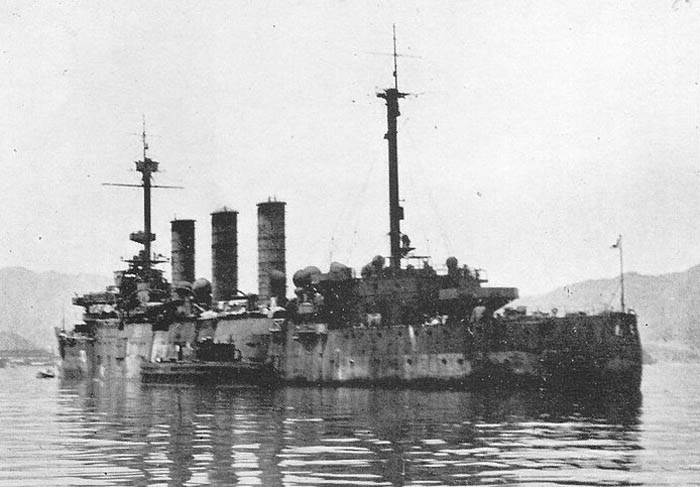
Yakumo 1946
Yakumo remained in the Seto Inland Sea for training until 1945. On 24 July TF 38 air raid on Kure caught her. She was damaged but survived, being re-designated “special transport ship” after the armistice. She started a new life as a repatriation transport on 7 December 1945, sent to Japanese overseas possessions, Taiwan and mainland China. Her last trip concluded by June 1946 with a total of 9,010 soldiers and personal. She was sent to Maizuru shipyard to be BU at Hitachi Shipbuilding & Engineering on 20 July 1946, until 1 April 1947.
Read More/Src
Books
Campbell, N.J.M. (1978). “The Battle of Tsu-Shima, Parts 2, 3 and 4”. In Preston, Antony (ed.). Warship. Vol. II. London: Conway Maritime Press. pp. 127–35, 186–192, 258–65. ISBN 0-87021-976-6.
Chesneau, Roger, ed. (1980). Conway’s All the World’s Fighting Ships 1922–1946. Greenwich, UK: Conway Maritime Press. ISBN 0-85177-146-7.
Chesneau, Roger & Kolesnik, Eugene M., eds. (1979). Conway’s All the World’s Fighting Ships 1860–1905. Greenwich: Conway Maritime Press. ISBN 0-8317-0302-4.
Corbett, Julian Stafford (1994). Maritime Operations in the Russo-Japanese War, 1904–1905. Annapolis, Maryland: Naval Institute Press. ISBN 1-55750-129-7.
Daiji Katagiri, Ship Name Chronicles of the Imperial Japanese Navy Combined Fleet (聯合艦隊軍艦銘銘伝,, Rengōkantai Gunkan Meimeiden), Kōjinsha (Japan), June 1988, ISBN 4-7698-0386-9
Evans, David & Peattie, Mark R. (1997). Kaigun: Strategy, Tactics, and Technology in the Imperial Japanese Navy, 1887–1941. Annapolis, Maryland: Naval Institute Press. ISBN 0-87021-192-7.
Forczyk, Robert (2009). Russian Battleship vs Japanese Battleship, Yellow Sea 1904–05. Botley, UK: Osprey. ISBN 978-1-84603-330-8.
Friedman, Norman (2011). Naval Weapons of World War One. Barnsley, South Yorkshire, UK: Seaforth. ISBN 978-1-84832-100-7.
Gardiner, Robert & Gray, Randal, eds. (1985). Conway’s All the World’s Fighting Ships 1906–1921. Annapolis, Maryland: Naval Institute Press. ISBN 0-85177-245-5.
Hackett, Bob & Kingsepp, Sander (2012). “IJN Yakumo: Tabular Record of Movement”. Kido Butai. Combinedfleet.com. Retrieved 14 April 2015.
Halpern, Paul S. (1994). A Naval History of World War I. Annapolis, Maryland: Naval Institute Press. ISBN 1-55750-352-4.
Jentschura, Hansgeorg; Jung, Dieter & Mickel, Peter (1977). Warships of the Imperial Japanese Navy, 1869–1945. Annapolis, Maryland: United States Naval Institute. ISBN 0-87021-893-X.
Kowner, Rotem (2006). Historical Dictionary of the Russo-Japanese War. Historical Dictionaries of War, Revolution, and Civil Unrest. Vol. 29. Lanham, Maryland: Scarecrow Press. ISBN 978-0-81084-927-3.
Lacroix, Eric & Wells, Linton (1997). Japanese Cruisers of the Pacific War. Annapolis, Maryland: Naval Institute Press. ISBN 0-87021-311-3.
Masahide Asai, Ship name examination of the Japanese Navy (日本海軍 艦船名考,, Nihon Kaigun Kansenmeikou), Tōkyō Suikōsha (fringe organization of the Ministry of the Navy), December 1928
Mauch, Peter (2011). Sailor Diplomat: Nomura Kichisaburo and the Japanese-American War. Harvard University Asia Center. ISBN 978-0-674-05599-5.
McLaughlin, Stephen (2011). “The Admiral Seniavin Class Coast Defense Ships”. Warship International. XLVIII (1). Toledo, Ohio: International Naval Research Organization: 43–66. ISSN 0043-0374.
Milanovich, Kathrin (2014). “Armored Cruisers of the Imperial Japanese Navy”. In Jordan, John (ed.). Warship 2014. London: Conway. ISBN 978-1-84486-236-8.
Saxon, Timothy D. (Winter 2000). “Anglo-Japanese Naval Cooperation, 1914–1918”. Naval War College Review. LIII (1). Naval War College Press. Archived from the original on 13 December 2006.
Silverstone, Paul H. (1984). Directory of the World’s Capital Ships. New York: Hippocrene Books. ISBN 0-88254-979-0.
Stewart, William (2009). Admirals of the World: A Biographical Dictionary, 1500 to the Present. Jefferson, North Carolina: McFarland & Co. ISBN 978-0-7864-3809-9.
Warner, Denis & Warner, Peggy (2002). The Tide at Sunrise: A History of the Russo-Japanese War, 1904–1905 (2nd ed.). London: Frank Cass. ISBN 0-7146-5256-3.
Links
combinedfleet.com Yakumo TROM
on navypedia.org/
on worldnavalships.com/
on admiral31.world.coocan.jp/
on history.navy.mil/
on history.navy.mil
on collections.sea.museum
reddit.com captain niimi masaichi and crew
on en.wikipedia.org/wiki/
commons.wikimedia.org/


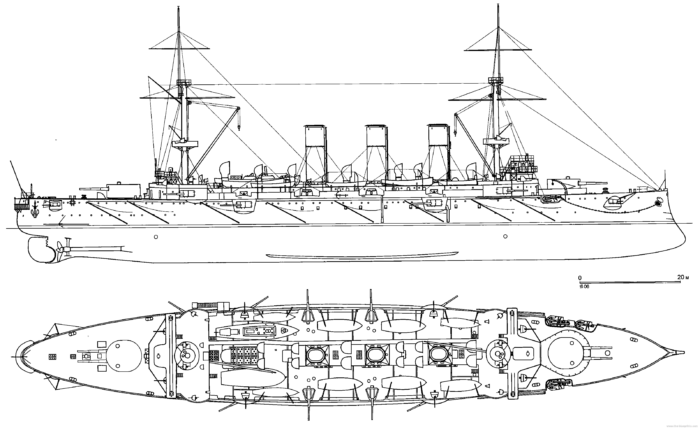
 Latest Facebook Entry -
Latest Facebook Entry -  X(Tweeter) Naval Encyclopedia's deck archive
X(Tweeter) Naval Encyclopedia's deck archive Instagram (@navalencyc)
Instagram (@navalencyc)





 French Navy
French Navy Royal Navy
Royal Navy Russian Navy
Russian Navy Armada Espanola
Armada Espanola Austrian Navy
Austrian Navy K.u.K. Kriegsmarine
K.u.K. Kriegsmarine Dansk Marine
Dansk Marine Nautiko Hellenon
Nautiko Hellenon Koninklije Marine 1870
Koninklije Marine 1870 Marinha do Brasil
Marinha do Brasil Osmanlı Donanması
Osmanlı Donanması Marina Do Peru
Marina Do Peru Marinha do Portugal
Marinha do Portugal Regia Marina 1870
Regia Marina 1870 Nihhon Kaigun 1870
Nihhon Kaigun 1870 Preußische Marine 1870
Preußische Marine 1870 Russkiy Flot 1870
Russkiy Flot 1870 Svenska marinen
Svenska marinen Søværnet
Søværnet Union Navy
Union Navy Confederate Navy
Confederate Navy Armada de Argentina
Armada de Argentina Imperial Chinese Navy
Imperial Chinese Navy Marinha do Portugal
Marinha do Portugal Mexico
Mexico Kaiserliche Marine
Kaiserliche Marine 1898 US Navy
1898 US Navy Sovietskiy Flot
Sovietskiy Flot Royal Canadian Navy
Royal Canadian Navy Royal Australian Navy
Royal Australian Navy RNZN Fleet
RNZN Fleet Chinese Navy 1937
Chinese Navy 1937 Kriegsmarine
Kriegsmarine Chilean Navy
Chilean Navy Danish Navy
Danish Navy Finnish Navy
Finnish Navy Hellenic Navy
Hellenic Navy Polish Navy
Polish Navy Romanian Navy
Romanian Navy Turkish Navy
Turkish Navy Royal Yugoslav Navy
Royal Yugoslav Navy Royal Thai Navy
Royal Thai Navy Minor Navies
Minor Navies Albania
Albania Austria
Austria Belgium
Belgium Columbia
Columbia Costa Rica
Costa Rica Cuba
Cuba Czechoslovakia
Czechoslovakia Dominican Republic
Dominican Republic Haiti
Haiti Hungary
Hungary Honduras
Honduras Estonia
Estonia Iceland
Iceland Eire
Eire Equador
Equador Iran
Iran Iraq
Iraq Latvia
Latvia Liberia
Liberia Lithuania
Lithuania Mandchukuo
Mandchukuo Morocco
Morocco Nicaragua
Nicaragua Persia
Persia San Salvador
San Salvador Sarawak
Sarawak Uruguay
Uruguay Venezuela
Venezuela Zanzibar
Zanzibar Warsaw Pact Navies
Warsaw Pact Navies Bulgaria
Bulgaria Hungary
Hungary

 Bundesmarine
Bundesmarine Dutch Navy
Dutch Navy Hellenic Navy
Hellenic Navy Marina Militare
Marina Militare Yugoslav Navy
Yugoslav Navy Chinese Navy
Chinese Navy Indian Navy
Indian Navy Indonesian Navy
Indonesian Navy JMSDF
JMSDF North Korean Navy
North Korean Navy Pakistani Navy
Pakistani Navy Philippines Navy
Philippines Navy ROKN
ROKN Rep. of Singapore Navy
Rep. of Singapore Navy Taiwanese Navy
Taiwanese Navy IDF Navy
IDF Navy Saudi Navy
Saudi Navy Royal New Zealand Navy
Royal New Zealand Navy Egyptian Navy
Egyptian Navy South African Navy
South African Navy






























 Ukrainian Navy
Ukrainian Navy dbodesign
dbodesign